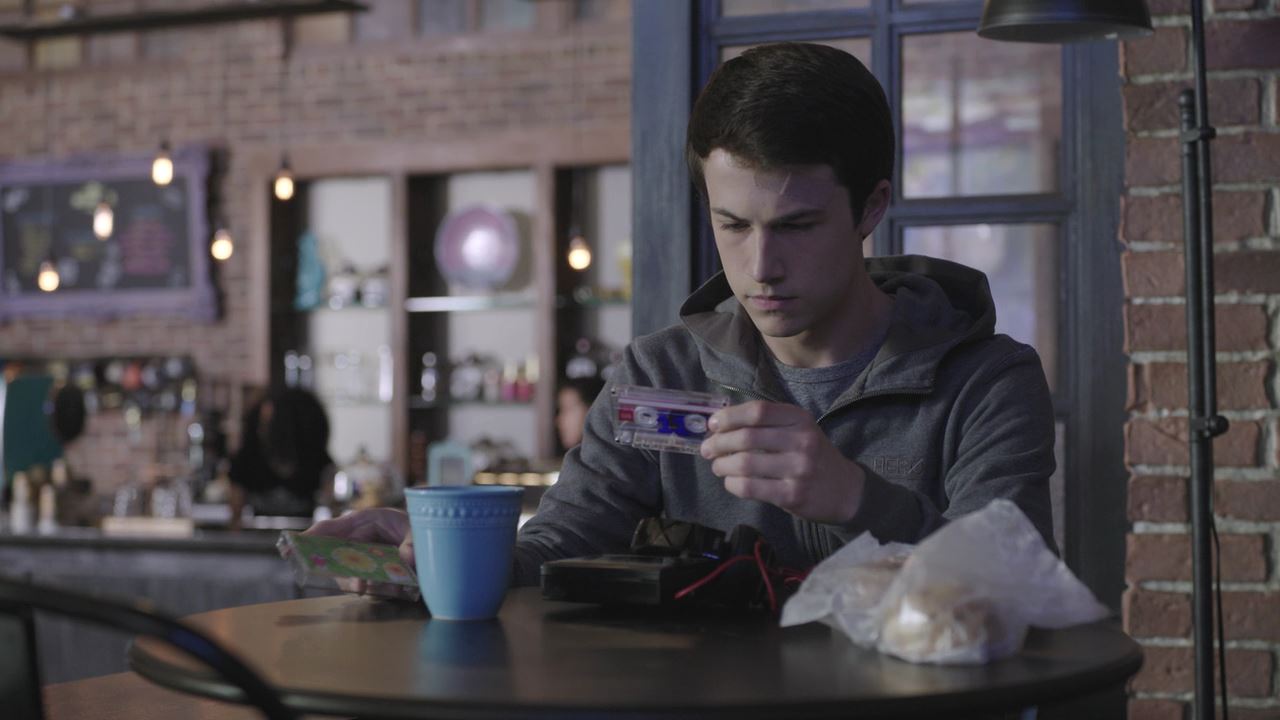This review is chock-full of spoilers!
As a pre-teen, I actively sought out the darkest, most disturbing young adult fiction available. Suicide, self-harm, eating disorders, partner abuse, sexual assault, drug addiction, alcoholism, chronic illness, death, death, death, car accidents, death — the more depressing, the better. I tried to remember that 12-year-old and her impeccable taste for poorly-written, loosely-plotted deep-dives into the lives of teenagers who burnt themselves with cigarettes and lusted after mysterious boys with abusive fathers as I sat, aghast, through all 13 episodes of 13 Reasons Why, based on a YA novel I will definitely never read but probably would’ve loved in 1992. Would she have noticed, for example, that this show is not only wildly irresponsible, but also just very poorly plotted? (No) Would she have given a shit about Clay Jensen, the unremarkable young man inexplicably centered and valorized at the center of a young woman’s story? (Yes) Would she have only been able to push through past Episode 2 because she wanted to get to the lesbian parts? (I don’t know.)
Ultimately, I’m pretty sure pre-teen me would’ve loved this as much as pre-teens all over the country apparently do love it. As a young depressive with a lot of mixed-up feelings I couldn’t sort out, stories like this made me feel less alone and gave me a reason to be sad/angry/disturbed, which was better than being sad/angry/disturbed for reasons I couldn’t identify, let alone articulate. But I also imagine that I would’ve had to watch this at a friend’s house, ’cause there is no way in hell my Mom would’ve let this shit fly.
13 Reasons Why tells the story of Hannah Baker, who, prior to slitting her wrists in the bathtub (which we witness in its full, graphic glory), recorded 13 cassette tapes, each dedicated to a different person who contributed to her decision to kill herself. Each tape subject is told to listen, then pass on the set to the next. We enter the story when Clay Jensen, #11, receives the box of tapes. Apparently, in the book, he listened to all 13 tapes in one night, like any rational person would. However, in order to turn the book into a 13-episode series, Clay takes long breaks between tapes to hunt down each tape’s subject and confront them about how they hurt Hannah. Many characters ask him or suggest to him that he finish the set before continuing this futile and inexplicable justice mission, but Clay will not, because Clay… is an idiot? No, because Clay is a fictional character, and his slow-listen is an unjustified plot device. That so much of the show’s action rests on this improbable decision of Clay’s is merely the ground floor of the skyscraper of aggravations this show built on the skyline of my week.

Like many of you, I knew of this show ’cause it’s at the top of the Netflix screen layout and due to the flurry of press coverage about the show’s “triggering” material and its potential bad influence on a teenage audience. I saw the headlines, but never read the articles, and never would’ve watched the show at all if not for the lesbian character I’m ostensibly going to evaluate in this review. It takes a lot for me to declare a show irresponsible or unnecessarily triggering, but holy shit this is reckless.
13 Reasons Why depicts graphic, explicit rape — we’re spared nudity (because that would be inappropriate!), but we’re immersed in unbridled violence. Not only do these scenes run exceptionally long, they’re also re-played, as characters’ memories, throughout subsequent episodes. Fight scenes between male characters, as well as Hannah’s actual suicide, are gratuitously gory. Nearly every teenager in this story is a low-key sociopath, but I was still jarred by a group of 50+ students enthusiastically witnessing a brutal brawl on the pavement, not one moved to intervene. Perhaps they could’ve cut all the gratuitously violent minutes and replaced them with the remainder of every scene that cut off after “I have to tell you something,” which was at least ten scenes. It ends up feeling like emotionally manipulative depression porn.
13 Reasons Why heavily hands us the butterfly effect theory via Hannah’s tapes, and aims to lay bare how a number of small, seemingly “harmless” incidents of cyberbullying, sexual harassment, slut-shaming or teasing can do irreparable damage to somebody’s psyche. It’s a noble enough aim, but the role mental illness plays in suicidality is never addressed. Over 90 percent of suicide victims have a mental illness at the time of death, and it’s rare that any one person, let alone 13 people, are “to blame.” The self-congratulatory commentary from show producers about their exploration of “real issues,” then, falls a bit flat. Most kids without a mental health diagnosis who experience what Hannah experiences don’t kill themselves — and they shouldn’t have to in order for teenagers to get the message that being an asshole is an asshole move.
Hannah’s tapes serve to “out” her various classmates for their negative actions towards her, bringing crimes into the light and forcing them to confront themselves and each other. I can’t think of a greater “fantasy outcome” from suicide than this. I say this as somebody who, as a teenager, had that exact fantasy. Not only are you freed from the slings and arrows of everyday teenage life, but everybody who was mean to you is forced to feel accountable for your demise. This is the text-book definition of glamorizing suicide! (Not to mention the glamour of Hannah herself — a relatively flawless angel, personality-wise, in a sea of teenage filth, as well as the not-incidential fact of her pillow-lipped, impeccably-jawed, princess-haired gorgeous physical appearance.) Hannah spares nobody, not even a fellow rape survivor, from bearing this weight. Bryce, a serial rapist enabled by privilege and jock-entitlement, being the topic of one tape, instead of the whole damn collector’s set, was its own criminal act, I swear to G-d.
To be clear, I’m aware that a lot of TV and movies romanticize suicide. That’s the nature of the beast when the beast is art, and sometimes artists do end up hurting some people in order to communicate a specific truth. But this show actively bills itself as being a responsible look at an important issue, it even justifies its own existence by citing its excellent commitment to dialogue on said issue. There’s a companion documentary wherein the crew pats themselves on the back for 30 minutes for allegedly saving lives.

I know I said this whole story was about Hannah, who is dead now, but it’s actually about Clay. He’s sensitive, relatively friendless, a little nerdy, awkward around girls, sometimes a spineless moron. You know the type. He’s often spotted lying to one person or another about doing a homework project with one person or another, wearing a band-aid for so many days that his forehead certainly should’ve turned to black mold and fallen off his body by episode seven, riding his bicycle around town like Brian Krakow because he’s not a cool kid with a car. He’s our Piper, the white cis het man at the center of a woman’s narrative. Eventually, Clay insists upon taking full responsibility for Hannah’s death because if he’d only told Hannah that he loved her, she would’ve survived! Clay will heroically avenge her death by yelling at people and mansplaining some really abysmal life advice to various women of color! If Hannah is attempting to teach these kids that they don’t know what somebody else might be going through, that message was certainly lost on Clay. If only I had the patience of Tony, the Latinx gay teenager who endures Clay’s very sub-par tape-listening skills, patiently supporting and guiding him through this emotional journey towards self-actualization for reasons entirely unknown, while meanwhile Clay pays so little attention to Tony that he manages not to notice that Tony is gay. For the first few episodes, I thought Tony might be Clay’s guardian angel, but he turned out to just be a standard-issue Magical Minority Person without supernatural powers.
Oh and there’s a lesbian! Her name is Courtney, she’s closeted and adopted and has two gay Dads and one of them is Ben from Queer as Folk. She’s popular and wants to stay that way. Her storyline starts out innocently enough and then goes bad, fast. After a drunken kiss with Hannah, which is photographed and subsequently sent via cell phone to the entire network of asshats at this terrible high school, Courtney throws Hannah under the bus to keep her own sexuality a secret.

In a later episode, Courtney defends a known rapist. (She does this during a meeting about top-secret information that its participants are holding, for some reason!, in a popular-amongst-students coffeehouse.) There’s one scene where Hannah’s voiceover declares that although boys can be “assholes,” “girls… girls are evil,” and the girl she’s talking about is Courtney. Just for the record, acts committed by these not-evil assholes include multiple rapes, sexual harassment, groping, spreading false rumors about sexual conquests, spreading sexual photographs taken without consent in order to slut-shame, stalking, beating each other up and planting drugs on Clay to stop him from ratting them out. Sorry but no — Courtney can be an asshole. But a lot of these boys… are evil. There’s a lot of potential in Courtney’s narrative — as the lesbian child of a lesbian Mom, I can definitively state that it’s a lot more complicated to come out under that situation than people assume. But we don’t get there. What may’ve been her coming out scene is one of the many cut off after she tells her Dad, “I have to tell you something.”
Admirably, the cast is very racially diverse, although this intersectionality is rarely addressed. There are several queer characters — three gay teenagers, two gay adults, Courtney the lesbian, and Hannah being slightly sexually fluid. It also made me cry twice, and the series definitely improved after the first few episodes.
But none of this can rescue the fundamental ridiculousness of the gimmick at the show’s core or its unmindful insistence that this show will not only do no harm, but actively encourage good.
If I ran the world, which let’s be real it’s only a matter of time before I do, this show would’ve been called either “13 Reasons Why Hannah Moved to a Womyn’s Land in Southern Oregon” or “13 Reasons Why Hannah Murdered Bryce but Shouldn’t Go To Jail For It.” Furthermore, Season Two would narrow the show’s focus onto its true shining stars: Laura, the one-episode two-line lesbian in a leather jacket; Tony, and the lawyer played by Wilson Cruz. I’d watch Wilson Cruz lay bricks, to be honest.






